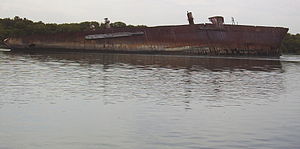Santiago (1856 ship)
  Wreck of the Santiago
| |
| History | |
|---|---|
| Name | Santiago |
| Builder | Henry Balfour, Methil, Fife, Scotland |
| Launched | 1856 |
| History | |
| Acquired | 1888 |
| History | |
| Acquired | 1890 |
| History | |
| Port of registry | Adelaide |
| Acquired | Appx. 1900 |
| Out of service | 1945 |
| Fate | Abandoned 1945 |
| Notes | Now in Garden Island Ships' Graveyard, near Port Adelaide, Australiahistoric shipwreck[1] |
| General characteristics | |
| Tons burthen | 455 tons |
| Length | 160 ft 7 in (48.95 m) |
| Beam | 25 ft 10 in (7.87 m) |
| Depth of hold | 17 ft 4 in (5.28 m) |
| Propulsion | sail |
| Sail plan | Barque |
The Santiago was a 455-ton barque launched in 1856. It was built by Henry Balfour of Methil, Fife for the Liverpool shipping company Balfour Williamson. It sailed mainly between Liverpool and Chile, but also to Australia. Its remnant hull, which lies in a ships' graveyard in South Australia, was considered 'the oldest intact iron hull sailing vessel in the world',[2] until part of the central section collapsed in January 2023.[3][4]
Career[edit]
After service with Balfour Williamson, she was sold in 1888 to a German company, and in 1890 to Norwegians. In 1901, the Adelaide Steamtug Company purchased the ship and sailed it from Newcastle, New South Wales to Port Adelaide with a cargo of coal. She was subsequently dismasted and used as a lighter.[5] On 21 December 1907, she was used by Adelaide Steamtug Company in association with other vessels to recover the steamer Jessie Darling, which had collided with and sunk on top of the unmarked wreck of the barque Norma on 21 April 1907. Norma had been sunk after a collision with the ship Ardencraig, several hours earlier at the Semaphore Anchorage.[6] In 1918 she was sold to the Adelaide Steam Co. and was used for occasional salvage work and lightering until 1945, when she was abandoned.
Fate[edit]
On 19 August 1945, she was towed to the eastern extent of the Port River's North Arm, and became the last vessel to be abandoned in what is now known as the Garden Island Ships' Graveyard.[7] In 1982, the Santiago was declared as an historic shipwreck under the South Australian Historic Shipwrecks Act 1981.[1] The wreck is officially located at 34°48′36″S 138°32′24″E / 34.81000°S 138.54000°E.[8] She has been the subject of study by various parties including the Society for Underwater Historical Research in 1978 and by the Department of Environment and Heritage on an ongoing basis since 1981,[9][10] and more recently by Flinders University in conjunction with the South Australian Maritime Museum.[11] In 1991, she was listed on the now-defunct Register of the National Estate.[12]
See also[edit]
References[edit]
- ^ a b Wotton, David (18 February 1982). "Historic Shipwrecks Act, 1981 Notice(s) under Section 5 (1) and Section 5 (2)" (PDF). The South Australian Government Gazette. South Australian Government. p. 422. Retrieved 4 April 2018.
- ^ Brouwer, N.J., 1999, International Register of Historic Ships, Peekskill, New York cited in Jeffery, B., 2003, South Australian Maritime Heritage Program 1970s – 2002 Projects, Activities and Bibliography, Heritage Branch, Department for Environment and Heritage, Adelaide, page 12.
- ^ "World's oldest iron vessel collapses in Port ship graveyard". The Advertiser. 13 January 2023. Retrieved 8 April 2023.
- ^ Historic ship collapses at Port Adelaide ABC Radio Adelaide, 13 Jan 2023. Retrieved 8 April 2023.
- ^ ‘The Shipping Trade,’ The Register (Adelaide, SA), Saturday 27 July 1901, page 6
- ^ 'The Jessie Darling raised,' The Advertiser (Adelaide, SA, Monday 23 December 1907, page 10.
- ^ "Santiago - Garden Island" (PDF). South Australian Government, Department of Environment and Water. Retrieved 4 April 2018.
- ^ "View Shipwreck - Santiago". Australian National Shipwreck Database. Australian Government, Department of Environment and Energy. Retrieved 4 April 2018.
- ^ Jeffery, W.F.; (1978), 'Project: Santiago', Annual Report 1978, Society for Underwater Historical Research, North Adelaide, SA, pages 8-9.
- ^ Jeffery, B., 2003, South Australian Maritime Heritage Program 1970s – 2002 Projects, Activities and Bibliography, Heritage Branch, Department for Environment and Heritage, Adelaide, page 12. Retrieved 9 July 2012.
- ^ Treasured Collections – Memories, Ship Memorabilia and Connections between People and the Garden Island Ships’ Graveyard, South Australian Maritime Museum. Retrieved 8 April 2023.
- ^ "Santiago Shipwreck – listing on the now-defunct Register of the National Estate (Place ID 6256)". Australian Heritage Database. Australian Government. 1991. Retrieved 4 April 2018.
Further Information[edit]
- Mary A. Reilly, Methil Heritage - Santiago retrieved 08/07/2012.
- 'Ships' Graveyards of SA – Santiago – Garden Island' brochure, retrieved 08/07/2012.
- Hartell, Robyn; Richards, Nathan (2001), Garden Island : ships' graveyard, Heritage South Australia, ISBN 978-0-7308-5894-2
